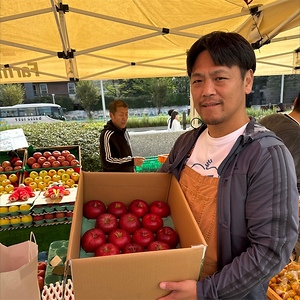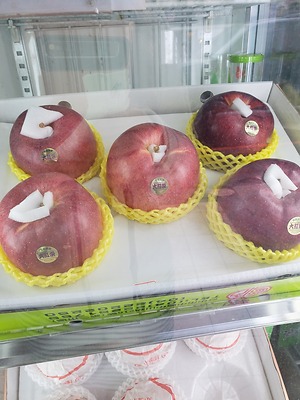


Daikouei Apples
Estimated Inventory, lb : 0
Description/Taste
Daikouei apples are medium to large in size, averaging 9 to 10 centimeters in diameter, and have a conical to oblate shape with flat shoulders, a broad middle, and a narrow, tapered base. The apples generally weigh 400 to 600 grams and have semi-thin, smooth, matte, and waxy skin. The skin also showcases prominent pale lenticels and has a yellow-green base almost entirely enveloped in a dark red, crimson, to maroon blush. The blush is saturated and solid with patches of dark striping. Underneath the surface, the ivory to pale yellow flesh is firm, dense, and aqueous with a crisp and crunchy consistency. The flesh also encases a moderately-sized central fibrous core filled with tiny black-brown inedible seeds. Daikouei apples emit a fruity aroma when ripe and can be consumed raw or cooked. The flesh is initially tangy, sour, and sweet when harvested. After storing the fruits for a few weeks to months, the flavor mellows, creating a balanced, sweet taste.
Seasons/Availability
Daikouei apples are harvested in the late fall through early winter. In professional cold storage, the apples can be kept for several months and reach peak flavor during the late winter through spring.
Current Facts
Daikouei apples, botanically classified as Malus domestica, are a modern Japanese variety belonging to the Rosaceae family. The mid-season cultivar was developed through natural breeding techniques in Japan and was registered as a commercial variety in 2005. Daikouei apples were selected for cultivation for the fruit's large size, saturated coloring, and mild taste. The apples are left unbagged during cultivation and hold well on the tree, remaining attached even during typhoons. Since their release, Daikouei apples have been sold domestically throughout Japan, and the variety has also achieved commercial success by being exported to China as a premium cultivar. Daikouei apples are popularly consumed fresh and can be used in a wide variety of sweet and savory preparations.
Nutritional Value
Daikouei apples are a source of potassium to balance fluid levels within the body, vitamin C to strengthen the immune system while reducing inflammation, and fiber to regulate the digestive tract. The apples also provide copper to develop connective tissues, magnesium to control optimal nerve functioning, calcium to build strong bones and teeth, and other nutrients, including vitamin A, manganese, zinc, phosphorus, vitamin K, and vitamin E. The vibrant red hues within the skin indicate the presence of anthocyanins, pigmented compounds with antioxidant-like properties to protect the cells against the damage and oxidative stress caused by free radicals.
Applications
Daikouei apples have a mild, sweet taste suited for fresh and cooked preparations. The variety is customarily consumed straight out of hand to enjoy the apple's firm flesh and juicy nature. In China and Japan, Daikouei apples are often peeled and served as a snack or after-dinner dessert. Daikouei apples can also be chopped into salads, shredded into slaws, sliced and served on cheese plates, or served with nut butter, caramel, or chocolate dips. Try layering Daikouei apple slices into sandwiches for added crunch, mixing into parfaits, or using them as an edible topping over other breakfast dishes such as pancakes, French toast, or waffles. In addition to fresh preparations, Daikouei apples can occasionally be used in cakes, crumbles, pies, muffins, and scones, or they can be sauteed in spices and browned butter and served as a topping over ice cream. The apples can also be blended into smoothies or pressed into juice for punches, cocktails, and carbonated beverages. Daikouei apples pair well with cheeses such as cheddar, parmesan, and blue, fruits including cherries, cranberries, citrus, and pears, spices such as ginger, cinnamon, nutmeg, and cloves, maple syrup, and vanilla. Daikouei apples will keep up to one month when stored in the refrigerator's crisper drawer.
Ethnic/Cultural Info
Daikouei apples are a popular variety imported from Japan into China for the Chinese New Year, also known as the Spring Festival or Lunar New Year. Consuming apples during the Chinese New Year is believed to bring protection and good health in the year to come. It is also eaten as a symbol of harmony, as the Chinese word for apple sounds similar to the word for peace or safety. During Chinese New Year celebrations, the more apples consumed, the healthier the future year will be. Daikouei apples are auspicious for their dark red coloring and are thought to contain big dreams due to their large size. The color red is a traditional hue during Chinese New Year, and legend has it that wearing red protects against the beast known as Nian. This mythical creature arrives on Earth each New Year's Eve to destroy crops and villages, and it is customary to place food on the doorstep to distract the beast and keep him from bringing destruction to the household. The story recounts that one night a child scared the beast with red clothing, sparking the tradition of wearing red as protection against Nian. Over time, red has expanded beyond the story of Nian and has evolved into a general symbol of protection, good health, prosperity, celebration, and luck. Daikouei apples are a favorite gift to wish friends and family good health, and the large, red fruits are displayed on plates or stacked into a small pile as an offering to ancestors in exchange for protection.
Geography/History
Daikouei apples were developed in the late 20th and early 21st centuries in the Aomori Prefecture, Japan. In 1992, one of the largest typhoons ever recorded, Typhoon Hagibis, also known as the Apple Typhoon and Typhoon No. 19, struck Japan and destroyed massive amounts of agricultural fields and orchards. After the typhoon, apple breeder Mr. Seiichi Kudo, who owned Yamase Farm in Hirosaki City, planted over 10,000 Miki Life apple trees in his garden. Mr. Kudo used those apple trees in natural crossbreeding techniques with open pollination to create hybrid seedlings that he would test and evaluate as potential new cultivars. Several years later, a seedling was selected, studied, and approved for cultivation sometime around 2001, and by 2005, the variety was registered in Japan as a new cultivar. The variety was initially known as Taiko or Taikoei apples and was later changed to Daikouei. Today Daikouei apples are primarily grown in the Aomori Prefecture, and only growers under contract can produce the luxury variety. Daikouei apples are sold through select markets, distributors, and grocers in Japan, and the apple is also exported to China and Taiwan.
Recipe Ideas
Recipes that include Daikouei Apples. One
| Who Needs A Cape |
|
Caramel Apple Yogurt Parfait |
| The DIY Lighthouse |
|
Cereal Yogurt Parfait |









